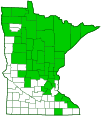fireweed
(Chamaenerion angustifolium)
Overview • Description • Distribution • Taxonomy
Fireweed is found at woodland edges, at the edges of sedge meadows, in bogs, and in ravines. It is also found in disturbed areas where trees and shrubs have been removed, including in burned or clear-cut forests and along roadsides. The flowers in the inflorescence mature from the bottom up. The stamens are erect at first and the style is sharply bent backward. After one or two days, the stamens bend backward, and the style straightens and opens up. Bees visiting the plant start at the bottom of the inflorescence and work their way to the top. When there is no more nectar to be collected, they proceed to the next inflorescence, again starting at the bottom. This system of male flower parts developing before female parts is known as protandry. It ensures that the plant will not self-pollinate. |
||
Description |
||
Fireweed is an erect, perennial, 8″ to 78″ tall forb that rises usually on a single aerial stem from a rhizome-like underground stem and fibrous roots. It often forms large colonies. The stem is smooth, hairless, and reddish-brown. The leaves are alternate and narrowly lance-shaped. The species epithet angustifolium means “narrow-leaved”. The margins are untoothed. The inflorescence is a dense, cylinder-shaped, spire-like cluster of many flowers at the top of the stem. The flowers are showy and bright pink to purple. Each flower has 4 petals and 4 sepals, and they are arranged in a radial symmetry. The fruit is a long, narrow seed pod filled with tiny seeds that are dispersed by wind. |
||
Distribution |
||||
|
Sources |
|||
| 4/20/2023 | ||||
Taxonomy |
|||
| Kingdom | Plantae (Plants) | ||
| Division | Tracheophyta (Vascular Plants) | ||
| Subdivision | Spermatophytina (Seed Plants) | ||
| Class | Magnoliopsida (Dicots) | ||
| Order | Myrtales (Myrtles, Evening Primroses, and Allies) | ||
Family |
Onagraceae (Evening Primrose) | ||
| Subfamily | Onagroideae | ||
| Tribe | Epilobieae | ||
Genus |
Chamaenerion (fireweeds) | ||
Species in the genus Chamaenerion were originaly placed in the genus Epilobium. A group of several species was later separated from Epilobium as the new genus Chamaenerion. Recently it was determined that the name Chamaenerion was invalid “because it was derived from pre-Linnean sources and is synonymous with Epilobium,” and the genus name was shortened to Chamerion. A more recent clarification of the internationational Code of Botanical Nomenclature (ICBN), now the International Code of Nomenclature (ICN), “correctly argued that the name of the segregated genus should be Chamaenerion.” Today (2023) there is little agreement as to the proper placement of the group. ITIS and USDA PLANTS use the name Chamerion angustifolium. NCBI, GRIN, GBIF, BONAP, Tropicos, Flora of North America, and iNaturalist use the name Chamaenerion angustifolium. Plants of the World Online and World Flora Online use the name Epilobium angustifolium. |
|||
Subordinate Taxa |
|||
Synonyms |
|||
Chamaenerion angustifolium Epilobium angustifolium |
|||
Common Names |
|||
fireweed French-willow great willow-herb (Canada) great willowherb (Canada) rosebay willowherb (Europe) willowherb |
|||
Visitor Photos |
|||||
Share your photo of this plant. |
|||||
| This button not working for you? Simply email us at info@MinnesotaSeasons.com. Attach one or more photos and, if you like, a caption. |
|||||
Bill Reynolds |
|||||
My honeybees worked this late summer plant. |
|||||
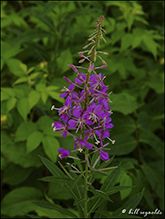 |
|||||
MinnesotaSeasons.com Photos |
|||||
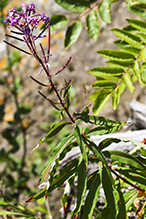 |
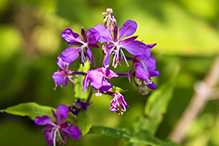 |
||||

Slideshows |
||
| Epilobium angustifolium Susanne Wiik |
||
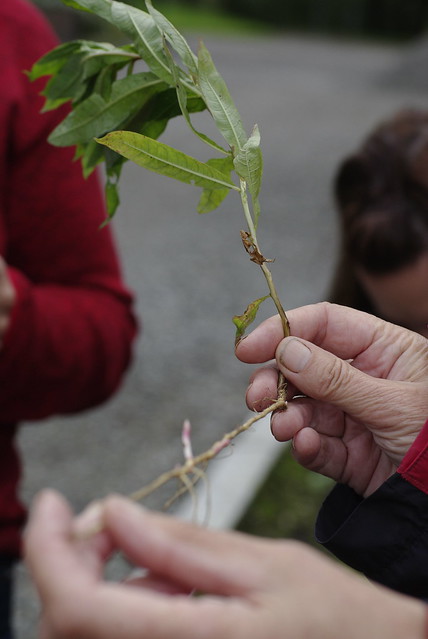
|
||
About
Geitrams fireweed |
||
| Fireweed DianesDigitals |
||
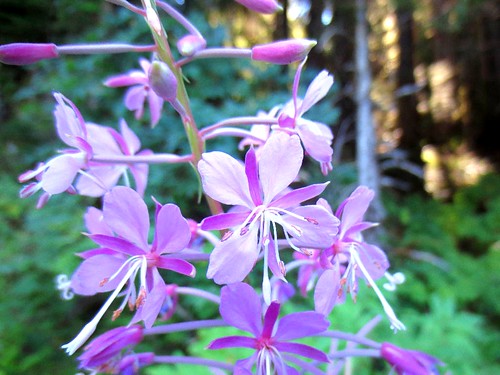
|
||
About
Copyright DianesDigitals |
||
| Fireweed Andree Reno Sanborn |
||
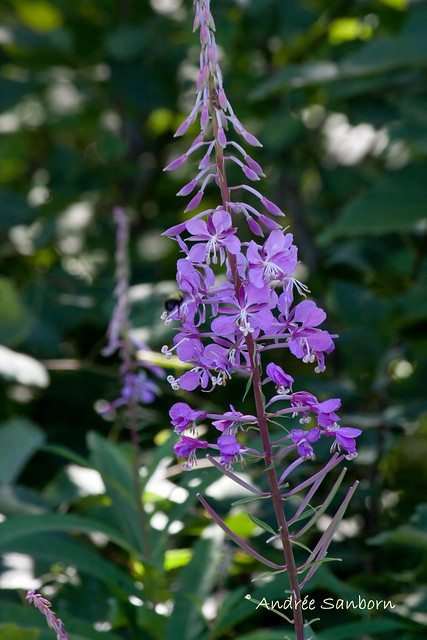
|
||
About
Epilobium angustifolium |
||
| Chamerion angustifolium (Fireweed) Allen Chartier |
||
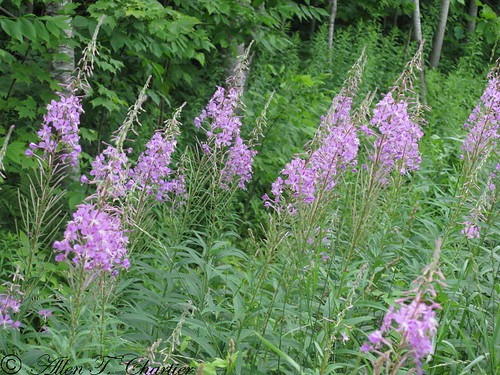
|
||

Visitor Videos |
|||
Share your video of this plant. |
|||
| This button not working for you? Simply email us at info@MinnesotaSeasons.com. Attach a video, a YouTube link, or a cloud storage link. |
|||
Other Videos |
|||
| Fireweed (Epilobium Angustifolium) / Great Willow-herb - 2013-07-13 W3stlander |
|||
About
Published on Aug 2, 2013 Published on Aug 2, 2013 Epilobium angustifolium, commonly known as Fireweed (mainly in North America), Great Willow-herb (some parts of Canada),[1] or Rosebay Willowherb (mainly in Britain), is a perennial herbaceous plant in the willowherb family Onagraceae. --------------- 50.77636 5.82428 |
|||
| Willowherb - Sigurskúfur - Dúnurt - Villijurtir - Sumarblóm Hellen Linda Drake |
|||
About
Published on Sep 6, 2013 Willowherb - Epilobium angustifolium - Chamerion angustifolium - Rosebay Willowherb - Fireweed - Dúnurt - Sigurskúfur Sigurskúfur (fræðiheiti: Epilobium angustifolium) er fjölær jurt af eyrarrósarætt. Hann tilheyrir dúnurtum og getur orðið allt að 70 cm á hæð. Sigurskúfur ber rauð blóm og er algengur um allt norðurhvel jarðar. Blómin eru mörg í klasa upp eftir plöntunni. Þau eru um 2 cm í þvermál. Krónublöðin eru rauð en bikarblöðin dökkrauð. Í hverju blómi er 8 fræflar. Frævan er löng og hærð. Blöðin standa gagnstætt á stilknum. Þau eru 4 til 12 cm á lengd og 1 til 2 cm á breidd. Þau eru lensulaga, heilrennd eða með litlar tennur og hárlaus. Sigurskúfur er áburðarfrekur og vex því gjarnan í kringum bæi - oft í þéttum breiðum. Í skóglendi og klettum vex hann villtur - blómstrar seint. Í gras- eða mólendi er hann stundum dvergvaxinn og blómstrar ekki vegna næringarskorts. Þá myndar hann 10 til 20 cm langa blaðsprota. : http://is.wikipedia.org/wiki/Sigursk%C3%BAfur Rosebay Willowherb is an adaptable friend. Most parts of the plant are edible, medicinal and have other fantastic properties. See more: http://awalkaroundbritain.com/knowledge/plant-and-tree/plant-profiles/rosebay-willowherb/ This herb is often abundant in wet calcareous to slightly acidic soils in open fields, pastures, and particularly burned-over lands; the name Fireweed derives from the species' abundance as a coloniser on burnt sites after forest fires. Its tendency to quickly colonize open areas with little competition, such as sites of forest fires and forest clearings, makes it a clear example of a pioneer species. The reddish-brown linear seed capsule splits from the apex. It bears many minute brown seeds, about 300 to 400 per capsule and 80,000 per plant. : http://en.wikipedia.org/wiki/Epilobium_angustifolium Willowherbs are typically very quick to carpet large swathes of ground and may become key or dominant species of local ecosystems. In and around the United Kingdom, for example, rosebay willowherb (E. angustifolium) is widely found in mesotrophic grassland dominated by false oat-grass (Arrhenatherum elatius), cock's-foot (Dactylis glomerata), and red fescue (Festuca rubra), while great willowherb (Epilobium hirsutum) is found in mesotrophic grassland with stinging nettle (Urtica dioica). These two willowherb species are also seen to dominate open habitat early in ecological succession, to the virtual exclusion of other plant life. Broad-leaved willowherb (Epilobium montanum) is found characteristically, though not abundantly, in the mesotrophic grasslands with meadowsweet (Filipendula ulmaria) and sometimes the uncommon Greek valerian (Polemonium caeruleum), which are peculiar to the Pennines. Most willowherbs will not tolerate shade trees and thus are limited to more recently disturbed patches, yielding to other plants over time. Consequently, though the genus contains many pioneer plants, rather few of them are invasive weeds of major importance. : http://en.wikipedia.org/wiki/Chamerion Rosebay willowherb is tolerant of acid and alkaline soils but does not grow in soils with poor mineral nutrition. Rosebay willowherb tolerates shade and a broad range of climatic conditions. It is suspected by some botanists that the sudden spread of rosebay willowherb was due to the introduction of the North American form that has 72 chromosomes while the native form has 36. Considerable intraspecific variation has been observed in rosebay willowherb in North America where it is eaten by deer and range cattle. It was also used as a food plant by the native indians. The nectar is important for hive bees in certain localities. Seeds remain viable for 18 months but do not form a persistent seedbank. Seeds lose viability after 18 months dry storage at room temperature but persist for more than 2 years stored dry at 5°C. : http://www.gardenorganic.org.uk/organicweeds/weed_information/weed.php?id=116 Á íslandi finnst fylgjandi jurtir af dúnurtum: Sigurskúfur er tiltölulega ný r landnemi á Íslandi : http://nature.is/frettir/1764/ Unfortunately handheld, with such a macro and a minuscule depth of field the video is shaky and not always on focus. |
|||
| sitting in the fire weed. lillith886 |
|||
About
Uploaded on Jul 19, 2010 stopped to watch the bees. whole place was buzzing but it doesn't come out on camera. my dog was mumphing. :-))) |
|||

|
Created: Last Updated: © MinnesotaSeasons.com. All rights reserved. |
